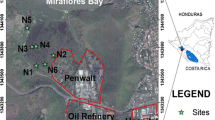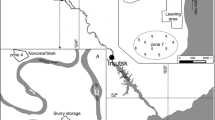Abstract
In a polluted site in Germany not only metallic, ionic and MeHg could be detected, but also organomercurials such as methyl- ethyl- and phenyl-mercury. In addition sometimes other organomercurials could be separated but up to now not identified. Extraction of the organomercurials from soil and percolating water was performed by dithizone, differentiation and detection by High-Performance-Liquid-Chromatography and atomic fluorescence detection, respectively. Differentiation between gaseous organic and gaseous elemental mercury was done by adsorption on Carbotrap® and gold filters, thermal desorption and detection by atomic fluorescence
The behaviour of 8 organomercurials in soil is described. For this a lysimeter of a new design was filled with polluted soil. The top layer of the soil was spiked with 8 organomercurials. The percolating water and the air above the soil, were analyzed. Different layers of the soil were also investigated after the experiment. By synthetic rain the movement of Hg species is low: the compounds stay in the first centimeters. Ethoxyethylmercury+, tolylmercury+, and nitromersol were not detected in the percocolate. Concentrations of phenylmercury+ and hydroxymercurybenzoicacid decreased. Methoxymethylmercury+ increased. In the head of the lysimeter, volatile Hg(0) concentration increased during 150 hours by a factor of 5, while volatile organic mercury decreased during this time by a factor of 10. The organomercurial-content in soil decreased.A transformation of organic to inorganic Hg is therefore presumed.
Similar content being viewed by others
References
Adam, K., Jönck, p., Gattner, H. & Zirngiebel, E. (1980):Quecksilber in: Bartholomé, E., Biekert, E., Hellmann, H., Ley, H., Weigert, W.M., Weise, E. (ed.) Ullmans Encyklopädieder technischen Chemie,19, 644.
Bergström, L. (1990):Environm. Poll.,67, 325–347.
Borg, H. & Johansson, K. (1989):Water, Air, Soil Poll.,47, 248–254.
Craig, P.J. (1986):Organomettalic Compounds in the Environment, Longman Harlow;
Hempel, M., Hintelmann, H. & Wilken, R.-D. (1992): Analyst,117, 669–672.
Hintelmann, H. & Wilken, R.-D. (1993): Appl. Organometall. Chem.,7, 173–180.
Hogg T.J., Stewart, J.W. & Bettany, J.R. (1978):J. Environ Qual.,7, 400–445.
Iverfeldt, Å & Johansson, K. (1988):Verh. Internat. Verein Limnol.,23, 1626–1632.
Mierle, G. (1990): Environm. Tox. Chem.,9, 843–851.
Mierle, G. & Ingram R. (1991): Water, Air, Soil Poll.,56, 349–357.
Wilken, R.-D., Hempel, M. & Hintelmann, H. (1993):Intern. Conf. on Heavy Metals in the Environment; Toronto Sept. 1993;1; 372–375.
Author information
Authors and Affiliations
Rights and permissions
About this article
Cite this article
Hempel, M., Wilken, R.D., Miess, R. et al. Mercury contaminated sites — Behaviour of mercury and its species in lysimeter experiments. Water Air Soil Pollut 80, 1089–1098 (1995). https://doi.org/10.1007/BF01189769
Issue Date:
DOI: https://doi.org/10.1007/BF01189769




